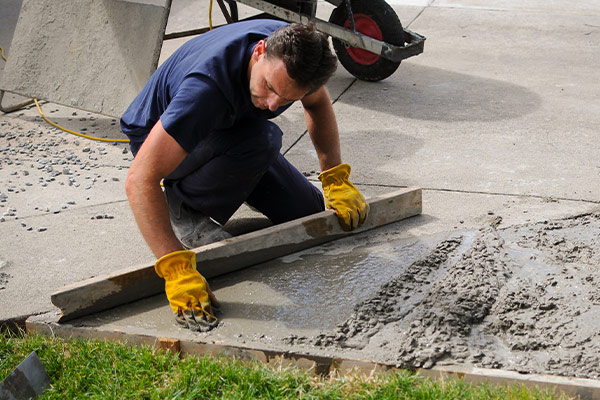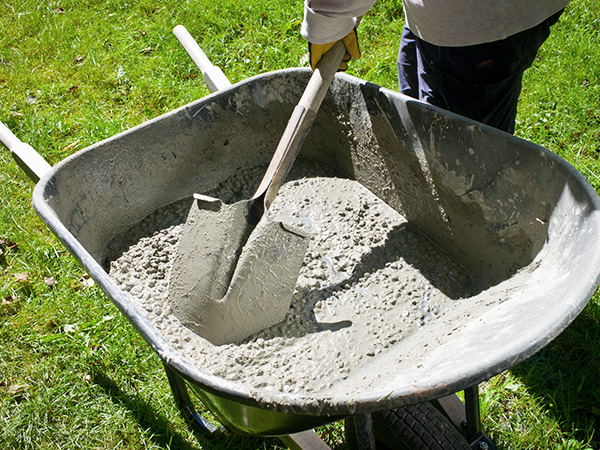

The Eternal Debate: Cement vs. Concrete
Who hasn't entered their opinion in the classic debate: is that cement concrete? Whether you’re admiring a new patio or sneaking your initials into a fresh sidewalk, you first have to determine what that substance is—cement or concrete.
The Basics, and the Basic Differences, Between Cement and Concrete
The first wrinkle in this puzzle is you need one item to make the other. Cement is actually a component used to make concrete. Cement acts as a binder, holding the sand and aggregate together when making concrete. Cement can be made from elements like limestone, silicon, shell, chalk, clay, and other frequently mined materials. Here’s how they come together:
- The elements are first heated to very high temperatures.
- Then water is added (called “slurry”).
- This mixture then forms a small ball (called a “clinker”).
- Once finished, clinkers are then ground into a powder. This substance is referred to as “portland cement”. (Not a name brand - it’s a standard ingredient for almost all concrete mixes).
- You then mix cement, water, aggregate, and sand to make concrete, in ratios that vary depending on your project.
Different Types of Cement
While concrete can be made from different materials, cement has five different formulations for specific uses.
Here are the five types of cement:
- Type 1: Is for normal, general use and you will see this most often. Sometimes labeled as “Ordinary Portland Cement (OPC)”.
- Type 2: Is used where cement will come in contact with soils and water with moderate sulfate, or where there are concerns about heat buildup.
- Type 3: Has high early strength properties, meaning it hardens faster than the normal 28-day hardening cycle of typical cement.
- Type 4: Is known as “low heat” cement, because it will put out less heat as it dries and hardens.
- Type 5: Is sulfate resistant and is good to use in conditions where there is high alkaline soil and water present.

Tips on Making Concrete
So, should you mix your own concrete? It can be confusing when you’re offered many different options, including “pre-mixed” and “ready-mixed” concrete in the store. But don’t worry, at McCoy’s we can solve this question for you.

“Pre-mixed” concrete is what comes in dry form by the bag at the hardware store or lumberyard. You can use it for small jobs like installing a new post for a fence, mailbox, flagpole, small patio, or sidewalk. It sets up quickly and you have to use it fast, so you’re not left with a new modern art sculpture titled, “Shovel in a bucket.”
“Ready-mixed” concrete is better for large jobs, like pouring a foundation for house. It comes in a concrete mixer from a distributor (like in a concrete truck) and is delivered to your project site. For big jobs like this, you will need rebar or mesh and other materials delivered. These materials are available at your local McCoy's.
Some tips whenever using concrete:
- Be careful not to let concrete touch your skin. Wear gloves and protect your face and eyes while mixing or working with concrete.
- Wear a mask or respirator to avoid breathing in fine concrete particles.
- Concrete cures through hydration, which is a chemical reaction. The water used in your concrete should be very clean – drinkable water is best – to avoid unexpected chemical reactions from contaminants.
- Concrete gets stronger as it ages and has a standard “28th Day Strength Rating” (when it is fully cured), but it’s usable in a day or two.
- Don’t over-add water! The less water added to concrete, the stronger it will be.
- Alternately, don’t under water your concrete, either, or you won’t be able to spread it effectively.
The Differences in Mortar
Another fun bit of cement trivia: Mortar Mix is also made from masonry cement as well as fine sand and lime. It’s the “glue” that holds bricks and other constructions like stone walls together. You add water and presto you can construct a brick wall or a stone barbeque. Types of mortar include grout, which you would use to set tile and “thin-set” which uses water-retaining agents to make an adhesive so you can attach materials like tile to cement board, and other places.
You can look for a lettering system to help identify different types of mortars, such as N for exteriors, O for interior (non-load bearing) walls, S for below-grade projects requiring high PSI strength, M for retaining walls and driveways, and K for restoring old projects or for use where a delicate touch is required.
Concrete Project Calculator
Are you working on a small DIY project that requires a concrete slab? Use this calculator to determine the amount of dry mix you need. Note: We suggest you consult a professional if you need concrete for a building foundation.
At McCoy's We Can Help You Answer the Big Questions
When it comes to choosing the right cement for your concrete job or mortar for your grout needs – we have all the right answers. Our experts can alleviate any concerns you have about buying the wrong thing for your project, and they’ll do it without making lots of jokes about “sticking to it” or “doing it the hard way.” Well, maybe just a few jokes.

Reviewed by David Dollar
McCoy's In-House Expert

